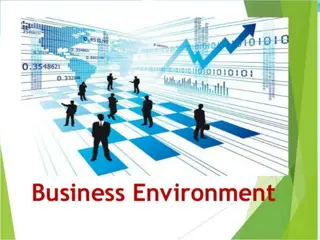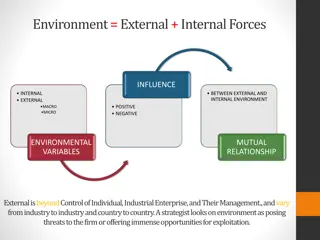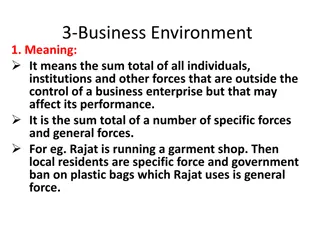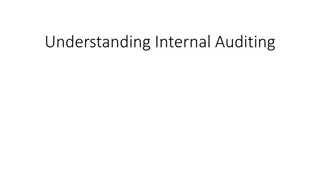Understanding Business Environment: Internal and External Factors
The business environment is shaped by a combination of internal and external factors that impact a company's operations. Internal factors like shareholders, management structure, and human resources are under the company's control, while external factors such as economic, social, technological, and political influences are beyond its control. The external environment is further divided into micro and macro environments, encompassing entities like suppliers, customers, competitors, and various market intermediaries.
Download Presentation

Please find below an Image/Link to download the presentation.
The content on the website is provided AS IS for your information and personal use only. It may not be sold, licensed, or shared on other websites without obtaining consent from the author. Download presentation by click this link. If you encounter any issues during the download, it is possible that the publisher has removed the file from their server.
E N D
Presentation Transcript
Meaning The combination of internal and external factors that influence a company's operating business environment can include factors such as: clients and suppliers; its competition and owners; improvements in technology; laws and government activities; and market, social and economic trends. situation. The
Components of Business Environment . Business Environment External Environment Internal Environment Promoters/shareholder s Mission/objectives Management structure Internal power relation Company image Research & Development Human Resources Marketing capabilities Macro Environment Economic environment Social environment Technological environment Natural environment Political environment Micro Environment Customers Suppliers Competitors Creditors Distributers
Types of Business Environment There are two types of business environment: Internal Business Environment 2. External Business Environment and External environment is divided into two categories (a)Micro Environment & (b)Macro Environment. 1.
Internal Environment These are those factors which can be controlled by the company and they directly affect the operations of the company. Types of Internal Environment: Shareholders 2. Mission & objectives 3. Management structure 4. Internal Power Relationship 5. Human resources, etc. 1.
External Business Environment Those factors which are beyond the control of business enterprise are included in external environment. External Environment is divided into two parts: 1. Micro Environment: The environment includes factors on which business has some control indirectly. 2. Macro Environment: it includes factors on which business has no control any how.
Micro Environment Suppliers: The party which supplies raw material or inputs. Customers: Wholesalers, Retailers, Industries, Govt. & other Institutions Marker Intermediaries: middleman, Marketing agencies, Financial intermediaries Competitors Public intermediaries, physical
Macro Environment Economic Environment: it refers to all the economic factors that affect commercial and consumer behaviour. It includes micro & macro economic condition. The factors includes interest rates, taxes, inflation, currency exchange rates, savings rates, unemployment depression, etc. rate, recession,
Macro Environment Political Environment: it includes all the rules & regulations, laws and roles of the govt. In the day to day functioning of the organisations. It includes factors like political stability, taxation policy of govt., foreign trade regulation, subsidies & tax concession
Macro Environment Social Environment: influence exercised by social and cultural factors, not within the control of business. It includes: attitude of people to work, family system, caste system, religion, education, marriage, taste & preference of consumer, trends, etc
Macro Environment Technological environment related to the technology to make operations more easy and efficient. The factors include innovation of new technology and upgradation of old one to win over the competition of company. environment: it refers to
Macro Environment Natural Environment: it includes natural resources, weather, climatic condition, topographical factors such as soil, sea, rivers, rainfall, etc. Every business unit must look for these factors before choosing the location for their business. port facilities,
Macro Environment International Environment: it is particularly important for industries directly depending on import & exports. The factors include: Globalization Liberalisation Foreign Business Policies Cultural exchange, etc.



























